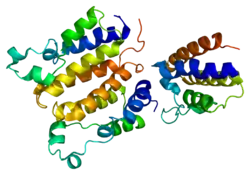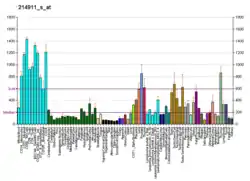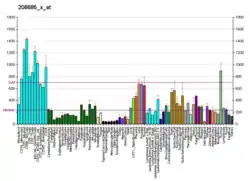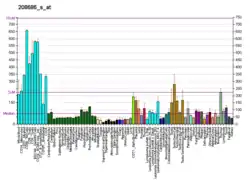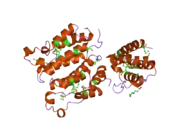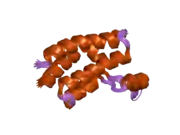BRD2
Bromodomain-containing protein 2 is a protein that in humans is encoded by the BRD2 gene. BRD2 is part of the Bromodomain and Extra-Terminal motif (BET) protein family that also contains BRD3, BRD4, and BRDT in mammals [5][6][7]
Early descriptions demonstrated that BRD2 gene product is a mitogen-activated kinase which localizes to the nucleus. The gene maps to the major histocompatibility complex (MHC) class II region on chromosome 6p21.3 but sequence comparison suggests that the protein is not involved in the immune response. Homology to the Drosophila gene female sterile homeotic suggests that this human gene may be part of a signal transduction pathway involved in growth control.[7]
Functions
- BRD2 has been implicated in cancer.[5][8]
- BRD2 loss in mice causes obesity without diabetes for unknown reasons.[5]
- BRD2 may have functional overlap with close homolog BRD3.[9]
- BRD2 function is blocked by BET inhibitors.
Interactions
BRD2 has been shown to interact with E2F2,[10][11] and many transcription factors including GATA1.[9]
References
- ENSG00000234507, ENSG00000230678, ENSG00000204256, ENSG00000235307, ENSG00000236227, ENSG00000234704 GRCh38: Ensembl release 89: ENSG00000215077, ENSG00000234507, ENSG00000230678, ENSG00000204256, ENSG00000235307, ENSG00000236227, ENSG00000234704 - Ensembl, May 2017
- GRCm38: Ensembl release 89: ENSMUSG00000024335 - Ensembl, May 2017
- "Human PubMed Reference:". National Center for Biotechnology Information, U.S. National Library of Medicine.
- "Mouse PubMed Reference:". National Center for Biotechnology Information, U.S. National Library of Medicine.
- Belkina, A. C.; Denis, G. V. (2012). "BET domain co-regulators in obesity, inflammation and cancer". Nature Reviews Cancer. 12 (7): 465–77. doi:10.1038/nrc3256. PMC 3934568. PMID 22722403.
- Thorpe KL, Abdulla S, Kaufman J, Trowsdale J, Beck S (October 1996). "Phylogeny and structure of the RING3 gene". Immunogenetics. 44 (5): 391–6. doi:10.1007/BF02602785. PMID 8781126. S2CID 44613743.
- "BRD2 bromodomain containing 2 [ Homo sapiens (human) ]".
- Shi, J; Vakoc, C. R. (2014). "The mechanisms behind the therapeutic activity of BET bromodomain inhibition". Molecular Cell. 54 (5): 728–36. doi:10.1016/j.molcel.2014.05.016. PMC 4236231. PMID 24905006.
- Stonestrom, A. J.; Hsu, S. C.; Jahn, K. S.; Huang, P; Keller, C. A.; Giardine, B. M.; Kadauke, S; Campbell, A. E.; Evans, P; Hardison, R. C.; Blobel, G. A. (2015). "Functions of BET proteins in erythroid gene expression". Blood. 125 (18): 2825–34. doi:10.1182/blood-2014-10-607309. PMC 4424630. PMID 25696920.
- Crowley, Thomas E; Kaine Emily M; Yoshida Manabu; Nandi Anindita; Wolgemuth Debra J (August 2002). "Reproductive cycle regulation of nuclear import, euchromatic localization, and association with components of Pol II mediator of a mammalian double-bromodomain protein". Mol. Endocrinol. United States. 16 (8): 1727–37. doi:10.1210/me.2001-0353. ISSN 0888-8809. PMID 12145330.
- Denis, G V; Vaziri C; Guo N; Faller D V (August 2000). "RING3 kinase transactivates promoters of cell cycle regulatory genes through E2F". Cell Growth Differ. UNITED STATES. 11 (8): 417–24. ISSN 1044-9523. PMC 3968681. PMID 10965846.
External links
- Human BRD2 genome location and BRD2 gene details page in the UCSC Genome Browser.
Further reading
- Haynes SR, Dollard C, Winston F, et al. (1992). "The bromodomain: a conserved sequence found in human, Drosophila and yeast proteins". Nucleic Acids Res. 20 (10): 2603. doi:10.1093/nar/20.10.2603. PMC 312404. PMID 1350857.
- Okamoto N, Ando A, Kawai J, et al. (1992). "Orientation of HLA-DNA gene and identification of a CpG island-associated gene adjacent to DNA in human major histocompatibility complex class II region". Hum. Immunol. 32 (3): 221–8. doi:10.1016/0198-8859(91)90059-I. PMID 1663500.
- Denis GV, Green MR (1996). "A novel, mitogen-activated nuclear kinase is related to a Drosophila developmental regulator". Genes Dev. 10 (3): 261–71. doi:10.1101/gad.10.3.261. PMID 8595877.
- Thorpe KL, Gorman P, Thomas C, et al. (1997). "Chromosomal localization, gene structure and transcription pattern of the ORFX gene, a homologue of the MHC-linked RING3 gene". Gene. 200 (1–2): 177–83. doi:10.1016/S0378-1119(97)00415-0. PMID 9373153.
- Taniguchi Y, Matsuzaka Y, Fujimoto H, et al. (1998). "Nucleotide sequence of the ring3 gene in the class II region of the mouse MHC and its abundant expression in testicular germ cells". Genomics. 51 (1): 114–23. doi:10.1006/geno.1998.5262. PMID 9693039.
- Guo N, Faller DV, Denis GV (2000). "Activation-induced nuclear translocation of RING3". J. Cell Sci. 113 (17): 3085–91. PMC 3936601. PMID 10934046.
- Denis GV, Vaziri C, Guo N, Faller DV (2001). "RING3 kinase transactivates promoters of cell cycle regulatory genes through E2F". Cell Growth Differ. 11 (8): 417–24. PMC 3968681. PMID 10965846.
- BelAiba RS, Baril P, Chebloune Y, et al. (2001). "Identification and cloning of an 85-kDa protein homologous to RING3 that is upregulated in proliferating endothelial cells". Eur. J. Biochem. 268 (16): 4398–407. doi:10.1046/j.1432-1327.2001.02355.x. PMID 11502199.
- Crowley TE, Kaine EM, Yoshida M, et al. (2003). "Reproductive cycle regulation of nuclear import, euchromatic localization, and association with components of Pol II mediator of a mammalian double-bromodomain protein". Mol. Endocrinol. 16 (8): 1727–37. doi:10.1210/me.2001-0353. PMID 12145330.
- Strausberg RL, Feingold EA, Grouse LH, et al. (2003). "Generation and initial analysis of more than 15,000 full-length human and mouse cDNA sequences". Proc. Natl. Acad. Sci. U.S.A. 99 (26): 16899–903. Bibcode:2002PNAS...9916899M. doi:10.1073/pnas.242603899. PMC 139241. PMID 12477932.
- Zhou M, Peng C, Nie XM, et al. (2003). "[Expression of BRD7-interacting proteins,BRD2 and BRD3, in nasopharyngeal carcinoma tissues]". AI Zheng. 22 (2): 123–7. PMID 12600283.
- Pal DK, Evgrafov OV, Tabares P, et al. (2003). "BRD2 (RING3) is a probable major susceptibility gene for common juvenile myoclonic epilepsy". Am. J. Hum. Genet. 73 (2): 261–70. doi:10.1086/377006. PMC 1180366. PMID 12830434.
- Mungall AJ, Palmer SA, Sims SK, et al. (2003). "The DNA sequence and analysis of human chromosome 6". Nature. 425 (6960): 805–11. Bibcode:2003Natur.425..805M. doi:10.1038/nature02055. PMID 14574404.
- Ota T, Suzuki Y, Nishikawa T, et al. (2004). "Complete sequencing and characterization of 21,243 full-length human cDNAs". Nat. Genet. 36 (1): 40–5. doi:10.1038/ng1285. PMID 14702039.
- Kanno T, Kanno Y, Siegel RM, et al. (2004). "Selective recognition of acetylated histones by bromodomain proteins visualized in living cells". Mol. Cell. 13 (1): 33–43. doi:10.1016/S1097-2765(03)00482-9. PMID 14731392.
- Beausoleil SA, Jedrychowski M, Schwartz D, et al. (2004). "Large-scale characterization of HeLa cell nuclear phosphoproteins". Proc. Natl. Acad. Sci. U.S.A. 101 (33): 12130–5. Bibcode:2004PNAS..10112130B. doi:10.1073/pnas.0404720101. PMC 514446. PMID 15302935.
- Gerhard DS, Wagner L, Feingold EA, et al. (2004). "The status, quality, and expansion of the NIH full-length cDNA project: the Mammalian Gene Collection (MGC)". Genome Res. 14 (10B): 2121–7. doi:10.1101/gr.2596504. PMC 528928. PMID 15489334.
- Benevolenskaya EV, Murray HL, Branton P, et al. (2005). "Binding of pRB to the PHD protein RBP2 promotes cellular differentiation". Mol. Cell. 18 (6): 623–35. doi:10.1016/j.molcel.2005.05.012. PMID 15949438.
